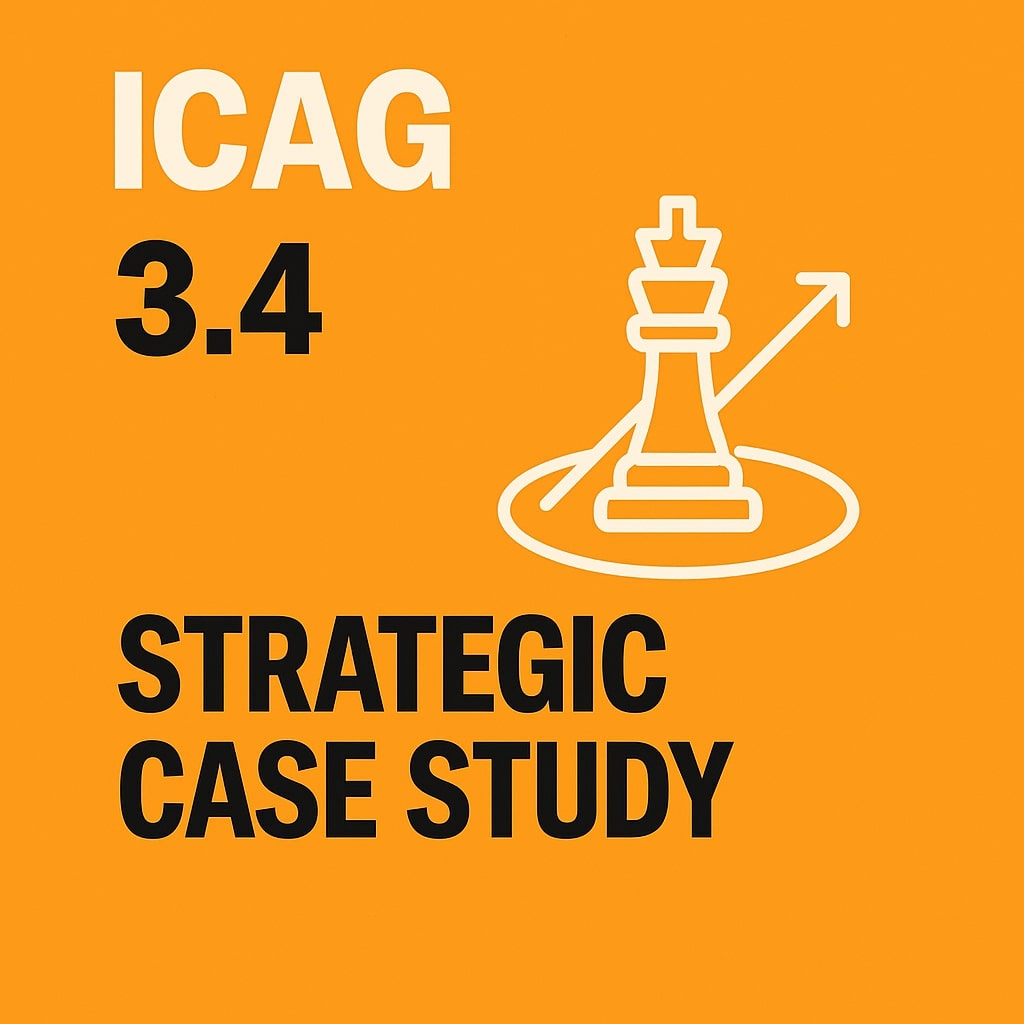The Strategic Case Study module (Paper 3.4) is part of the Professional Level (Level 3) in the ICAG professional qualification syllabus. It builds on foundational concepts from the Knowledge and Skills Levels, focusing on enabling students to understand and apply tools and models to develop skills in strategic analysis, choice, and implementation. Students will become competent in the use of management information to measure and monitor strategic performance, undertake a comprehensive review of good governance practice within applicable ethical frameworks, and evaluate complex scenarios based on data, financial and stakeholder analysis, including making recommendations.
Below is the syllabus coverage in tabular form, including main topics and their approximate weightings (guiding study time and exam mark allocations).
| Syllabus Topic | Description | Weighting (%) |
|---|---|---|
| A. Strategic analysis | Define the purpose of organisational strategy and explain the difference between the various levels: Corporate strategy, business/service strategy, functional strategy, operational strategy. Analyse the key factors and drivers that influence strategic objectives: Maximisation of shareholder value, stakeholder analysis and management (stakeholder mapping), vision and mission, impact of stakeholder expectations in the development of organisational objectives, balanced scorecard, core values, culture (e.g., Handy’s culture types, 3 levels/layers of culture & organisational cultural web model), risk appetite, laws and regulations. Ethics and strategy: The meaning of ethics, theories of ethics, business ethics across organisational functions, why ethical problems occur in business, ethics in a global economy, ethics, law and illegal corporate behaviour, the core elements of ethical reform, analysing ethical problems in business, models of ethical judgement, ethics and accounting: a decision-making model, sustainable competitive advantage and/or sustainable community benefit. Corporate social responsibility and environmentally driven strategy: The meaning of corporate social responsibility, basic elements of social responsibility, the limits of corporate social responsibility, economic, legal and social responsibilities, areas of social responsibility, corporate social responsibility in a global context, environment, social and governance responsibilities, implementing social responsibility programmes, key elements of managing the social responsibility. Evaluate various approaches to organisational strategy: Systems-based approach, resource-based approach, core competencies based approach, rational strategy, adaptive, emergent strategy. Explain the importance of technological developments on an organisation’s ability to achieve its strategic objectives. Prepare and evaluate, for a specified scenario, an external analysis: International business environment and global economic factors, Porter’s diamond analysis, general or macro environmental analysis, PESTLE analysis, industry and competitive analysis, Porter’s five forces, strategic group analysis, scenario plans, technological developments, including cyber security risks and the use of artificial intelligence. Determine the key issues arising from an environmental analysis: Logical approaches (SWOT analysis), creative approaches (such as blue sky thinking), gap analysis. Prepare and present advice on the strategic capability of the organisation. Identify and evaluate opportunities and challenges brought by digital technologies for firms, industries and society. Evaluate the risks attached to a proposed course of action and propose actions for the management of risk. Analyse and evaluate the impact of recent developments in technology, including big data, data analytics, artificial intelligence and robotic processes. Evaluate and advise on the suitability/acceptability/feasibility of strategic options. | 20 |
| B. Strategic choice | Explain and analyse the approaches to strategic choice and prepare business plans for a specified scenario, for an efficient and effective implementation of an organisational strategy. Analyse and apply approaches to strategy implementation: McKinsey 7-S framework, Henry Mintzberg’s theory of 5 building blocks & 6 organisational configurations. Evaluate the use of business plans in strategy implementation: Alignment of service delivery with public communication plans, integration of operational and work plans, alignment of human resource plans and personal objectives, integration of budget assumptions, management of internal and external messages. Evaluate monitoring procedures used in strategy implementation: Establishing a planned programme, types of monitoring procedures, key performance indicators. Prepare business plans to implement a chosen strategy and achieve objectives: Developing a performance management approach involving the identification of key performance metrics, both quantitative and qualitative; developing a marketing and brand management approach, involving both quantitative and qualitative techniques; developing a business risk management approach involving: identification of risks, assessing risk impact, management and mitigation of risks; developing an information, data and information technology approach, involving the provision of information to support new organisational and strategic requirements, including consideration of: impact of information systems on organisations, relationship between information systems/information technology strategy and corporate strategy, role of information systems/information technology in creating competitive advantage, impact of information technology on organisations, the impact of contemporary developments in information technology on organisational strategy, the impact of e-commerce on organisations and business, cyber security and big data management; development of a human resourcing approach, including recruitment and remuneration considerations; preparation of a schedule to meet the objectives and tasks contained in the business plan. | 15 |
| C. Strategy into action/Strategy implementation | Recommend and justify appropriate methods for an organisation to implement and monitor strategy. Evaluate and advise on international strategic choices and strategies: Reasons for globalisation, market drivers, cost drivers, government drivers & competitive drivers, models for international strategies, EPRG model/Management orientation, Integration/Responsiveness Framework (IR Matrix), 5 stages of globalisation, models of entry into foreign market/international market, exporting, licensing, franchising, strategic alliance, joint venture and wholly owned subsidiaries. Evaluate and advise an organisation in a specified scenario on the available corporate strategic choices: Directional/Scope Strategies (growth strategies using Ansoff growth vector matrix – market penetration, market development, product development, and diversification strategies (conglomerate/unrelated diversification and concentric/related diversification – horizontal & vertical integration – backward vertical integration and forward vertical integration), consolidation/stability strategies, withdrawal/harvesting/defensive restructuring strategies – Corporate insolvency & Restructuring Act, 2020 (Act 1015)); Portfolio matrices – evaluation of strategic business units (Boston Consulting Group Matrix, Public Sector Matrix, GE/McKinsey Directional Policy Matrix, Shell Directional Policy Matrix, Ashridge Portfolio Display Matrix); Corporate parenting (value adding and value destroying activities, corporate parenting rationale: portfolio manager, synergy manager, parental developer, generic parenting styles: financial control style, strategic planning style, strategic control style). Evaluate and advise an organisation in a specified scenario on competitive and business strategies: Porter’s generic competitive strategies (low cost leadership strategies, differentiation, focus strategies: focus low cost strategy, focus differentiation strategy), Bowman strategy clock (no frills strategy, low price strategy, hybrid strategy, differentiation strategy, focused differentiation strategy, strategies bound to fail). Evaluate and advise an organisation in a specified scenario on strategy development methods: Organic/Internal/Do it Yourself (DIY) Method, mergers and acquisitions, strategic alliances, joint ventures. Demonstrate professional scepticism and judgement in monitoring strategy. Recognise the ethical implications of developing strategy and suggest solutions to resolve ethical dilemmas. Discuss how data and management information can be used to monitor performance and achievement of objectives. | 25 |
| D. Financial objectives and strategies | Evaluate the issues involved in the formulation of an organisation’s financial strategy for a specified scenario. Determine and explain financial strategy objectives, taking account of the constraints on various elements of financial strategy. Explain stakeholder interests and their effect on financial strategy formulation and propose resolutions to stakeholder conflicts. Identify ethical problems in financial strategy and propose appropriate resolutions. Evaluate financial strategies in terms of the financial and strategic objectives of the organisation, including consideration of the application of: Investment appraisal techniques, shareholder value analysis, including EVA and SVA, lease or buy decisions, working capital and liquidity management, international financial management including specific considerations for multi-nationals, transfer pricing, risk management, treasury management including the management of risks relating to currency and interest rates using derivatives. Evaluate the available financing options: Short, medium and long-term alternatives, methods of raising new capital, issues of new capital, gearing and capital structure, dividend policy. Forecast financing requirements for both short and long-term financing requirements. Evaluate alternative methods of financing, incorporating the impact of tax, and select an appropriate financial plan. Prepare a financial plan and evaluate the impact of uncertainty on the plan. | 20 |
| E. Corporate governance | Discuss and evaluate the role of corporate governance in Ghana and internationally, and describe, explain and apply the processes of improving governance in organisations, for a specified scenario. Explain and analyse the corporate governance landscape in Ghana: Importance of the structure of ownership and control, directors and board structure, the role of non-executive directors, the role of directors in corporate governance, executive remuneration, the role of institutional investors in corporate governance, disclosure and corporate governance, internal control and corporate governance, the role of external audit and internal audit in corporate governance. Advise on the relevance of the provisions of relevant legislation where appropriate: The State Interest and Governance Authority (SIGA) Act, 2019 (Act 990) – governance of state-owned enterprises, Bank of Ghana Corporate Governance Disclosure Directives, Corporate Governance in Companies Act, 2019 (Act 992). Contrast corporate governance in the private sector with public governance. Explain and apply the OECD Principles of Corporate Governance and the Ghana Corporate Governance Code for Listed Companies 2020. Describe the role of the accountant in the process of corporate governance. Describe and explain the governance framework and key principles. Apply, evaluate and recommend actions, for a specified scenario, the principles contained in the Good Practice Guidance, including specific consideration of IFAC’s Code of Ethics for Professional Accountants. | 20 |



